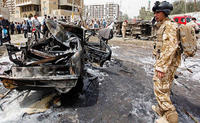-
States lack expertise, staff to deal with cyberthreats to utilities
The vulnerability of national electric grids to cyberattacks has caught the attention of federal utility regulators and industry safety groups, but state commissions tasked with regulating local distribution utilities are slow to respond to emerging cybersecurity risks. The annual membership directory of state utility regulators lists hundreds of key staff members of state commissions throughout the country, but not a single staff position had “cybersecurity” in the title.
-
-
California bill banning use of antibiotics in livestock withdrawn

The Centers for Disease Control and Preventionreports that 23,000 people die every year from infections that cannot be cured, often due to overuse of antibiotics which creates drug resistant bugs. Last Wednesday, California Assemblyman Kevin Mullin (D-San Mateo) withdrew proposed legislation which would ban the sale of meat and poultry fed on nontherapeutic antibiotics. He lacked sufficient support from fellow legislators.
-
-
Virginia lawmakers mull limiting police use of license plate readers
Some Virginia lawmakers are planning to propose legislation which will limit the police use of license plate readers (LPRs). The state currently has no laws restricting how police collect or store license plate data gathered by LPRs. Last year, then-Attorney General Ken Cuccinelli said he believed Virginia State Police should be restricted from capturing and storing license plate data outside of a specific, ongoing criminal investigation, but for now, police departments across the state have adopted their own measures.
-
-
South Carolina withdraws MOX lawsuit against DOE, NNSA
The state of South Carolina said Friday that it would not go ahead with its lawsuit against the Department of Energy and the National Nuclear Security Administration (NNSA) in support of the Savannah River Site’s Mixed Oxide (MOX) Fuel Fabrication Facility. The dismissal of the lawsuit follows an announcement last Tuesday by the DOE and NNSA that construction will continue on the MOX facility through the end of the fiscal year. The two agencies made it clear, though, that they still plan to mothball the plant.
-
-
Lawmakers want DOE to reduce run-away costs of S.C. plutonium processing plant
Lawmakers have given the Obama administration two weeks to submit a plan for reducing the cost of constructing the mixed-oxide fuel conversion (MOX) facility which would convert bomb-grade plutonium into nuclear fuel. The MOX facility at the Savannah River Site, South Carolina was launched to help the United States meet its nuclear arms reduction agreement with Russia, and agreement which called for the two countries to dispose of at least thirty-four metric tons each of weapons-grade plutonium.
-
-
Teaching under siege in Nigeria gripped by fear of Boko Haram
The world is waking up to Boko Haram. More than 200 schoolgirls kidnapped from the classes last month remain missing. A car bomb in Abuja on 1 May killed at least 19 people. Figures released by the International Crisis Group indicate that more than 4,000 people have been killed since the insurgency began. The war has displaced more than half a million inhabitants, ravaged the economy of an already impoverished region and put stress on relations between Muslims and Christians as well as among Muslims. Education has been singled out for violent attacks with lethal regularity since early 2012. No less than twenty schools have been burnt, and the attacks on schools and the killing of students and teachers has become a war strategy of Boko Haram.
-
-
U.S. officials say Israel softening position on nuclear deal with Iran
Israel’s official position on any agreement reached between the world powers and Iran over Iran’s nuclear program is “zero, zero, zero,” that is, Israel insists that the agreement should clearly stipulate that Iran should have no centrifuges to enrich uranium, no centrifuge production capability, and no heavy-water reactor and the means to extract weapon-grade plutonium from it. American officials say, however, that informally there has been a softening of Israel’s position, and that it now appears clear that Israel no longer regards the zero- zero, zero option as realistic and achievable.
-
-
Lawmakers urge NRC not to exempt shut-down nuclear plants from emergency, security regulations
Lawmakers are urging the U.S. Nuclear Regulatory Commission (NRC) to halt exemption of recently- shuttered nuclear power plants from emergency-planning and security regulations. The lawmakers are especially concerned about the nuclear waste which will continue to be stored on the grounds of shut-down nuclear plants, saying that the stored radioactive waste continues to be a security threat whether or not the plant itself is still operational.
-
-
Gerry Adams arrest: peace process in Northern Ireland can’t take much more pressure

The arrest last week of Sinn Féin leader Gerry Adams for questioning relating to the 1972 murder of Jean McConville threatens to undermine an established peace process in Northern Ireland, a process where the Rubicon has already been crossed, involving political sacrifice on all sides. Last December, following negotiations with all sides to the conflict, U.S. diplomat Richard Haass proposed a way to deal with outstanding issues in the peace process, a proposal which saw the past firmly on the agenda. The Adams arrest contradicts the Haass proposal, as it continues with the eclectic and incoherent approach to dealing with the open issues from a painful past. The Haass proposals may not be perfect, but experience from other countries shows that no perfect mechanism for dealing with the past exists. The key question now is not how to get to something better. It is a choice between Northern Ireland having a dedicated thought-through forum in which to contend with the past, or being forced to make do with political and legal institutions that were not designed to deal with it. The peace process has come too far, with both sides sacrifices to get this far. Its achievements should not be treated so carelessly.
-
-
Using biometrics to protect India’s one billion people raises security, privacy concerns
The cutting edge of biometric identification — using fingerprints or eye scans to confirm a person’s identity – is not at the FBI or the Department of Homeland Security. It is in India. India’s Aadhaar program, operated by the Unique Identification Authority of India (UIDAI) and created to confirm the identities of citizens who collect government benefits, has amassed fingerprint and iris data on 500 million people. It is the biggest biometric database in the world, twice as big as that of the FBI. It can verify one million identities per hour, each one taking about thirty seconds. The program unnerves some privacy advocates with its Orwellian overtones.
-
-
Governments more likely to negotiate with terrorists as violence increases: study

For decades, the hard line approach to national terrorism cases has called for governments not to negotiate with terrorists. This approach also asserted that terrorism is ineffective. A new study is proposing, however, that in certain cases the opposite may be true.“Instead of asking whether terrorism is effective, we should be concentrating on when and for what purpose is terrorism effective, especially since the empirical record shows that terrorism has both hurt and helped the causes of violent organizations that have employed the tactic,” the author writes.
-
-
Sinn Féin’s president Gerry Adams arrested over 1972 murder
Sinn Féin president Gerry Adams was arrested on Wednesday for questioning about one of the most notorious IRA murders during the Troubles. Detectives in Antrim questioned Adams about the execution of Jean McConville, a widowed mother of 10 who was dragged from her west Belfast home in 1972, tortured, and shot in the back of the head. McConville was one of the “Disappeared” – IRA victims whose bodies were buried so they would never be found — and her body was not discovered until 2003. Adams’s arrest and questioning follows a ruling by a court in the United States which compelled Boston College to hand over to the Police Service of Northern Ireland recorded interviews with veteran IRA members about McConville’s murder.
-
-
U.S. should significantly reduce incarceration rate: study
There has been an unprecedented and internationally unique rise in U.S. state and federal prison populations, from 200,000 inmates in 1973 to 1.5 million in 2009. This increase occurred because of policy decisions such as mandatory sentencing, long sentences for violent and repeat offenses, and intensified criminalization of drug-related activity. Given the minimal impact of long prison sentences on crime prevention and the negative social consequences and burdensome financial costs of U.S. incarceration rates, which have more than quadrupled in the last four decades, the United States should revise current criminal justice policies to significantly reduce imprisonment rates, says a new report from the National Research Council. The dramatic rise in prison population “not serving the country well,” the report says.
-
-
Western intelligence: Assad plans to retain residual chemical weapons capability
Israeli intelligence officials say the regime of President Bashar Assad in Syria may be concealing a small amount of the chemical weapons in its possession, while pretending that it is fully cooperating with the process to remove all chemical weapons from Syria. This assessment is similar to conclusions reached by the U.S. and U.K. intelligence communities in the past two weeks. The Israeli view is that the retention of chemicals by the Assad regime has to do with the ongoing fight against the rebels, and is not an indication that the regime is contemplating their use against Israel. A senior intelligence source also said that unlike the consensus in the intelligence community a year or two ago, the Israeli defense establishment no longer considers bringing down the regime in Damascus as necessarily positive for Israel.
-
-
DHS cancels acquisition of BioWatch’s Generation 3 technology
Owing to concerns about BioWatcheffectiveness and high cost, DHS has canceled plans to install an automated technology meant to speed the 24-hour operations of the program, the nation’s system for detecting a biological attack.ASeptember 2012 GAO report estimated that annual costs to operate the Generation 3 technology would be “about four times more” than the existing BioWatch system.
-
More headlines
The long view
Factories First: Winning the Drone War Before It Starts
Wars are won by factories before they are won on the battlefield,Martin C. Feldmann writes, noting that the United States lacks the manufacturing depth for the coming drone age. Rectifying this situation “will take far more than procurement tweaks,” Feldmann writes. “It demands a national-level, wartime-scale industrial mobilization.”
No Nation Is an Island: The Dangers of Modern U.S. Isolationism
The resurgence of isolationist sentiment in American politics is understandable but misguided. While the desire to refocus on domestic renewal is justified, retreating from the world will not bring the security, prosperity, or sovereignty that its proponents promise. On the contrary, it invites instability, diminishes U.S. influence, and erodes the democratic order the U.S. helped forge.
Fragmented by Design: USAID’s Dismantling and the Future of American Foreign Aid
The Trump administration launched an aggressive restructuring of U.S. foreign aid, effectively dismantling the United States Agency for International Development (USAID). The humanitarian and geopolitical fallout of the demise of USAID includes shuttered clinics, destroyed food aid, and China’s growing influence in the global south. This new era of American soft power will determine how, and whether, the U.S. continues to lead in global development.
Water Wars: A Historic Agreement Between Mexico and US Is Ramping Up Border Tension
As climate change drives rising temperatures and changes in rainfall, Mexico and the US are in the middle of a conflict over water, putting an additional strain on their relationship. Partly due to constant droughts, Mexico has struggled to maintain its water deliveries for much of the last 25 years, deliveries to which it is obligated by a 1944 water-sharing agreement between the two countries.
How Disastrous Was the Trump-Putin Meeting?
In Alaska, Trump got played by Putin. Therefore, Steven Pifer writes, the European leaders and Zelensky have to “diplomatically offer suggestions to walk Trump back from a position that he does not appear to understand would be bad for Ukraine, bad for Europe, and bad for American interests. And they have to do so without setting off an explosion that could disrupt U.S.-Ukrainian and U.S.-European relations—all to the delight of Putin and the Kremlin.”
How Male Grievance Fuels Radicalization and Extremist Violence
Social extremism is evolving in reach and form. While traditional racial supremacy ideologies remain, contemporary movements are now often fueled by something more personal and emotionally resonant: male grievance.
